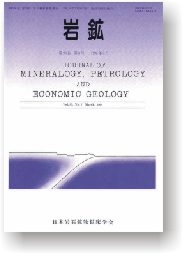All issues

Volume 92, Issue 11
November
Displaying 1-3 of 3 articles from this issue
- |<
- <
- 1
- >
- >|
ORIGINAL ARTICLES
-
Shoichi KOBAYASHI, Tetsuya SHOJI, Xianguo MENG, Jun DING, Hiroaki KANE ...1997Volume 92Issue 11 Pages 445-453
Published: 1997
Released on J-STAGE: September 14, 2006
JOURNAL FREE ACCESSMassive- and vein-type rodingites occurring in serpentinized peridotite of the Jinchan ultramafic body in the Ailaoshan ophiolite zone, S.W. China, have been investigated mineralogically and chemically. Rodingites of the massive-type consist of garnet, chlorite and diopside in rims, and garnet, diopside and subordinary chlorite in cores, while rodingites of the vein-type consist of garnet, chlorite and subordinary diopside. The garnet of the massive rodingites belongs essentially to the grandite-hydrograndite series, but extremely rich in TiO2: (Ca5.92Mg0.07)Σ5.99(Ti1.11Al0.44Fe1.112+Fe1.323+Cr0.02)Σ4.00(SiO4)5.78(O4H4)0.22. The petrography suggests that the rodingites were originally formed by metasomatism between titanium- and iron-rich and aluminum-poor rock and calcium-rich solution, and that they were deformed by the Ailaoshan metamorphism after the formation.View full abstractDownload PDF (1445K) -
Masatsugu OGASAWARA1997Volume 92Issue 11 Pages 454-464
Published: 1997
Released on J-STAGE: September 14, 2006
JOURNAL FREE ACCESSTanegashima, an island situated south of the Kyushu island, in the Outer Zone of Southwest Japan, contains small amounts of Miocene igneous rocks which intruded into the Kumage Formation of the Shimanto Supergroup. The quartz-porphyry occurs near Shimama in the southern part of the island, and is peraluminous and rich in K2O, Rb and Sn. The geochemical characteristics indicate that the quartz-porphyry is derived from S-type magma. The lamprophyre is present in the northern part of the island. K-Ar ages of the Shimama quartz-porphyry and the lamprophyre are 15.6±0.8 Ma and 18.2±0.9 Ma, respectively. The ages indicate two episodes of igneous activity on the island. The age of the Shimama quartz-porphyry is similar to the ages of a quartz-porphyry and a small granitoid body in the northeastern part of Yakushima, an island situated 20 km west of Tanegashima, but is slightly older than the main body of the Yakushima granite. The ages and geochemical characteristics of quartz-porphyries from the two islands suggest that they could be derived from a common magmatic event. The magmatic activity is considered to be part of Miocene acidic magmatism of the Outer Zone of Southwest Japan.View full abstractDownload PDF (1518K) -
Tahseenullah KHAN, M. Qasim JAN, M. Asif KHAN, A. Bakhsh KAUSAR1997Volume 92Issue 11 Pages 465-479
Published: 1997
Released on J-STAGE: September 14, 2006
JOURNAL FREE ACCESSA thick succession of metasedimentary and metavolcanic rocks has been reported for the first time in the Gilgit area. This succession (the Jaglot Group) comprises from bottom to top 1) the Gilgit Formation, 2) the Gashu Confluence Volcanics, and 3) the Thelichi Formation. The Gilgit Formation consists of thick turbiditic sediments interstratified with amphibolites and calc-silicates. The lower contact of the formation is not exposed, but presumably underplated by the Chilas Complex, and the upper contact is conformable with the Gashu-Confluence Volcanics. The Gilgit Formation contains more than 80% paragneisses and schists showing metamorphism up to the sillimanite grade. The paragneisses are strongly deformed and at places migmatized.
The paragneisses of the Gilgit Formation are quartz rich, but also contain biotite, garnet, staurolite, kyanite, sillimanite, graphite, together with pyrite and magnetite. Petrographical and geochemical data show that they are metapelites, semi-metapelites and semi-metapsammites. Using geothermometry and geobarometry on garnet-biotite pairs, the estimated maximum temperature and pressure conditions are 640°C and 6.7 kbar, respectively. We assume that igneous intrusions, both the Chilas Complex and the Kohistan Batholith and crustal thickening accompanying arc accretion to the Karakoram plate might have ensued metamorphism in the Gilgit Formation and other lithological units of the Jaglot Group. As depicted by the chemical zonation profiles of garnets in two samples from Jutial, the grade of metamorphism in the metasediments of the Gilgit Formation seems to increase from top to bottom in a normal sequence. The field and laboratory studies show almandine amphibolite subfacies and sillimanite-almandine amphibolite subfacies metamorphic conditions for the Gilgit Formation, and ocean basin of a back-arc affinity for its deposition.View full abstractDownload PDF (2924K)
- |<
- <
- 1
- >
- >|